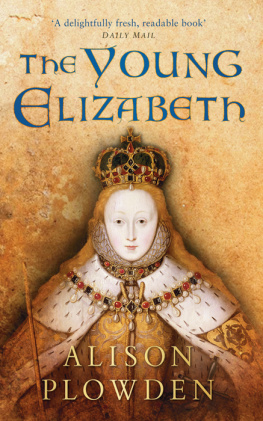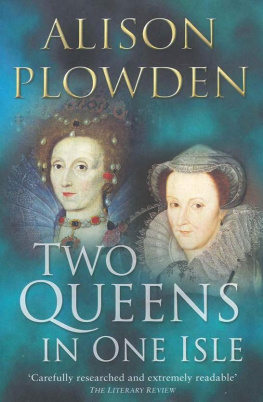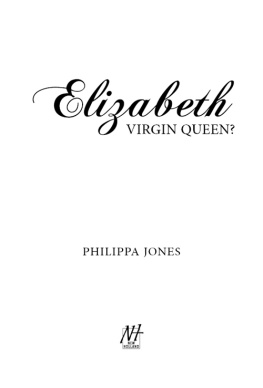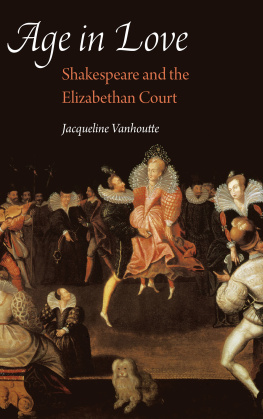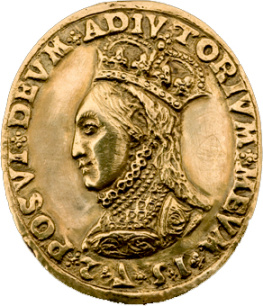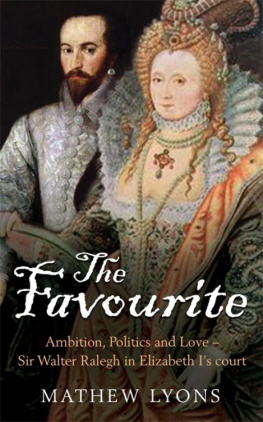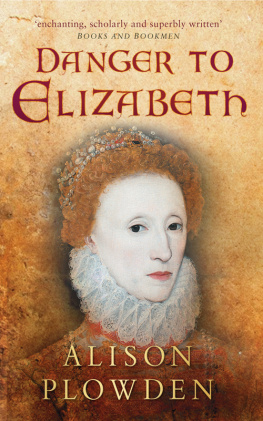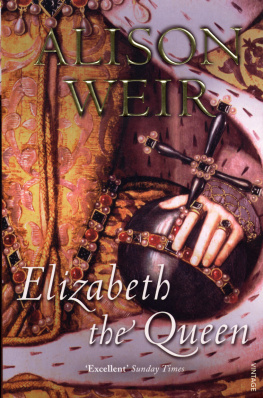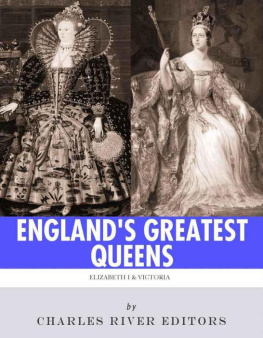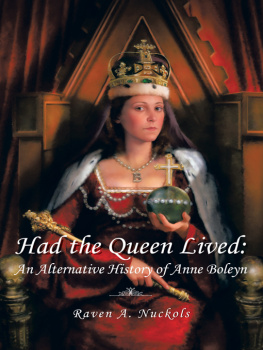Praise for Alison Plowdens Elizabethan Quartet
The expert and scholar ought to give Miss Plowden the fullest marks for remarkable accuracy
Jasper Ridley
Glasgow Herald
a vastly interesting account
The Times
Miss Plowden brings to the whole period perceptive judgment and wide sympathy
Irish Times
it would be difficult to praise too highly Alison Plowdens Danger to Elizabeth her extraordinarily fine book
Church Times
Enchanting, scholarly and superbly written, warmly recommended
Charity Blackstock
Books and Bookmen
the sustained concentration on the subject and the balanced intellectual control of the elements involved make it the work of a scholar
Stephen Wade
Catholic Herald
Professors have something to learn from perceptive women in penetrating the very feminine psychology of Elizabeth I
A.L. Rowse
Sunday Telegraph
She writes with verve, brevity and often wit a most entertaining book which, at the same time, is accurate and judicious
Paul Johnson
Evening News
an absorbing portrait of possibly the greatest tease in history
Publishers Weekly, USA
a model of clarity
G.M. Wilson
Times Literary Supplement
In Happy and Grateful Memory
Contents
A T three oclock in the afternoon of Thursday, 29 May 1533, Queen Anne Boleyn, Marquess of Pembroke, most dear and well-beloved wife of Henry VIII, embarked at Greenwich for the journey up-river to the Tower at the beginning of her coronation celebrations. She was escorted by an impressive contingent of the nobility and by the Lord Mayor and Aldermen, with all the crafts of the City of London in barges sumptuously decorated with banners and streamers and cloth of gold, and plentifully supplied with bands of musicians making great melody. In fact, such was the gunners enthusiasm, that not a single pane of glass survived either in the Tower or neighbouring St Katherines.
On Saturday, the thirty-first, came the recognition procession through the City to Westminster, and no expense had been spared to make it a memorable occasion. The great cavalcade, shimmering with gold and crimson, silver and purple and scarlet, wound its way through freshly gravelled and gaily decorated streets. The Queen herself, dressed in white cloth of tissue and sitting in her hair as one observer put it, rode in a litter of white cloth of gold drawn by two palfreys caparisoned to the ground in white damask. At every point of vantage along the route pageants and tableaux were presented, children spoke carefully rehearsed pieces in welcome and praise, and all afternoon the conduits and fountains ran with wine.
The climax of splendour was reached on the following day, Whitsunday, with the coronation ceremony itself when
Queen Anne was brought from Westminster Hall to the Abbey of St Peters with procession, all the monks of Westminster going in rich copes of gold with thirteen abbots mitred; and after them all the Kings Chapel in rich copes with four bishops and two archbishops mitred, and all the Lords going in their Parliament robes, and the crown borne afore her by the Duke of Suffolk, and her two sceptres by two Earls, and she herself going under a rich canopy of cloth of gold, apparelled in a kirtle of crimson velvet powdered with ermines and a robe of purple velvet furred with powdered ermines over that, and a rich coronet with a caul of pearls and stones on her head, and the old Duchess of Norfolk bearing up her train, and the Queens Chamberlain staying the train in the midst.
In the Abbey itself, set in her seat royal before the high altar, Anne Boleyn was anointed and crowned Queen of England by the Archbishops of Canterbury and York, and so sat crowned in her seat royal all the Mass and offered also at the said Mass. Afterwards, at the banquet in Westminster Hall, she occupied the place of honour at the high table under the Cloth of Estate, served by the nobility of England, while the minstrels made goodly sweet harmony in the background and the King looked on from a place which he had had made from which he could see without being seen.
This was Annes moment of triumph a moment which for six years she had worked and schemed to bring about, conducting a dangerous and difficult campaign with cold-blooded courage, tenacity and skill. It only needed now for the child she was so visibly carrying to be a healthy boy and her tremendous gamble a gamble which had brought the former maid-of-honour to the second highest place in the land would finally have paid off beyond all possibility of doubt.
CHAPTER I
T HE story of Elizabeth Tudor began just over a hundred years before she was born. It began with a love story with the romance of a young widowed queen and a gentleman of Wales.
Katherine of Valois, called the Fair, daughter of the King of France, had been married to that notable warrior, King Henry V of England, hero of Agincourt, in June 1420 a marriage designed to seal the Treaty of Troyes which was to inaugurate perpetual peace between the two countries. Two years later, on the last day of August 1422, Henry died of dysentery at the Castle of Vincennes just outside Paris. Katherine became a widow shortly before her twenty-first birthday, and her son, Harry born at Windsor who was destined to lose all the glory his father had gained, became King Henry VI at the age of nine months.
The youthful Queen Dowager, stranded in a foreign country and probably both bored and lonely, presently found diversion with one of the gentlemen of her household, Owen Tudor, her Welsh Clerk of the Wardrobe. Following more her appetite than friendly counsel and regarding more her private affections than her open honour, as the chronicler Edward Hall put it. Understandably perhaps, for Owen is described by Polydore Vergil as being adorned with wonderful gifts of body and mind, and by Hall as a goodly gentleman and a beautiful person garnished with many godly gifts both of nature and of graces. Another (earlier) chronicle was less complimentary, referring to him tersely as a man of neither birth nor livelihood.
Years later, Owens grandson, the first Tudor king, was to be somewhat embarrassed by certain reproachful and slanderous assertions about the deficiencies of his pedigree, and felt it necessary to appoint a commission consisting of the Abbot of Valle Crucis, Doctor Owen Poole, canon of Hereford, and John King, herald, to enquire into the matter. After visiting Wales and consulting the bards and other authorities, these seekers after knowledge drew up their masters perfect genelogie from the ancient Kings of Britain and Princes of Wales. The Tudors, they said, could prove lineal descent by issue male, saving one woman (an artistic touch), from Brute the Trojan mythical first King of the Britons, who was supposed to have given his name to the land.
In actual fact, however, the founder of the family fortunes appears to have been Ednyfed Fychan, who served the rulers of Gwynedd the principality of North Wales as seneschal or steward, from approximately 1215 to his death in 1246. Ednyfed was evidently highly thought of by his employers, for they rewarded him with extensive grants of land in Anglesey and Caernarvon. He also acquired estates in West Wales, and he and his relatives were allowed the unusual privilege of holding their lands free from restriction, excepting homage and military service in time of war.
The conquest and subjugation of Wales by England in 1282 does not seem to have adversely affected Ednyfeds descendants. On the contrary, by the middle of the next century, the seneschals great-great-grandson, Tudurap Goronwy, had emerged as a considerable landowner. Like a number of other Welsh magnates, he probably supported the English crown and Goronwy, eldest of his five sons, served with the army in France. It was the unsuccessful revolt of Owen Glendower in the early 1400s which brought about the familys downfall. Through their mother, Tudurs sons were first cousins to Glendower. Old loyalties reasserted themselves and the remaining four brothers (Goronwy had died in 1382) threw in their lot with the rebel chieftain. The consequences were disastrous. Rhys, the middle brother, was executed in 1412 and all the family estates were confiscated; though the property at Penmyndd in Anglesey was later returned to Goronwys heirs.
Next page
